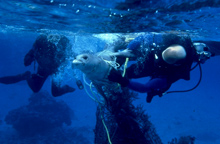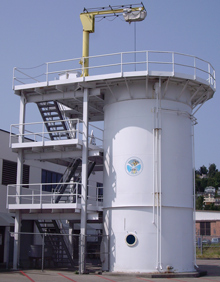What Lies Beneath? The NOAA Diving Program Helps Find Out
The NOAA Diving Program (NDP) is headquartered at the NOAA Diving Center in Seattle, Washington. NDP trains, certifies, and equips scientists, engineers, and technicians to perform the variety of tasks carried out underwater to understand, manage, and conserve our nation's marine resources. NDP ensures that all NOAA diving operations are conducted safely, efficiently, and economically.

NOAA divers often serve as underwater mechanics. Here, NOAA divers install a Coral Reef Early Warning System station to monitor conditions leading to degradation of coral reefs.
In conditions ranging from the crystal clear water of a pristine marine sanctuary to the murky, polluted water of a congested harbor, NOAA divers take the plunge, seeking answers below the water’s surface. On any given day, NOAA divers may be seen deploying and retrieving scientific instruments, documenting the behavior of fish and other marine animals, performing emergency and routine ship repair and maintenance, assessing human impacts on the environment, and locating and charting submerged objects.
Diving has always played an important role in helping NOAA collect information needed to protect and manage our nation’s resources. By physically “being there,” divers can interact with their environment and make real-time decisions about the tasks at hand. For shallow water diving to 300 feet and less, diving is a very safe and cost-effective means of collecting data and performing work underwater.
With more than 400 divers, NOAA has the most divers of any civilian federal agency. NOAA's reputation as a leader in diving and safety training has led to frequent requests from other government agencies to participate in NOAA diver training courses. For almost 50 years, NOAA and its predecessors have been actively involved in conducting and promoting undersea research.
How We Got There: Early Diving History
NOAA has a rich history of diving that actually precedes the official formation of NOAA in 1970. In the late 1940s and early 1950s, the Bureau of Commercial Fisheries (BCF) and the Coast and Geodetic Survey (C&GS) used diving for undersea research. These two federal programs provided the basic foundation for the development of the NOAA Diving Program some 20 years later.
Bureau of Commercial Fisheries

NOAA divers work to free an endangered monk seal that is entangled in marine debris—fishing nets that have been lost or discarded. Debris is a threat to marine animals and fragile coral reefs. Click image for larger view.
Diving was first used by BCF in Alaska around 1948, to assess abalone stocks. Between 1957 and 1960, BCF divers in Seattle began trawl diving studies to evaluate configurations of experimental net designs. During this same time, operating standards and regulations were developed for BCF diving activities. With minor changes, these regulations and operating polices were used as the template for structuring the NOAA Diving Program.
BCF laboratories immediately recognized the value of being able to evaluate fishing gear and conduct studies of various fish-recovery systems exactly where they will be used—underwater. As program expansion occurred, training programs were developed and other BCF laboratories assembled dive teams for on-site observations and assessments. From 1965 to 1973, scientists conducted numerous fisheries studies using scuba and surface-supplied diving equipment throughout the Gulf of Maine and North Atlantic.
Coast and Geodetic Survey
Dr. Harris B. Stewart, one of the pioneer diving scientists in the country, joined C&GS in 1957. One year later, the first operational use of scuba diving in the C&GS took place at Winyah Bay, South Carolina, when divers installed a platform and mounted a radio‑current meter to monitor water currents. A second scuba operation took place that same year to study migrating sand waves on Georges Bank off the northeast coast of the United States. In 1959, Dr. Stewart participated in operation "Drum Drop" on Brown's Ledge in Buzzard's Bay, Massachusetts, in 90 feet of water to study the disposal of radioactive waste at sea.
In the 1960s, scientific diving operations significantly expanded within the C&GS. For example, diving was used to determine depths of shoal soundings and install tide gauges in the Gulf of Mexico; Puget Sound, Washington; and Alaska.
Government reorganization in 1965 relocated the C&GS within the Environmental Science Services Administration (ESSA). While under ESSA, the C&GS diving program lacked a central management structure and a diver certification and training program. Divers on different coasts were trained by various means of instruction. The C&GS program was also adversely impacted by the loss of experienced personnel, which often resulted in new, inexperienced divers developing on-the-job skills with little overall guidance. In response to the diver training problem, C&GS developed a one‑week, 60‑hour training course, which was first conducted in Miami, Florida, in 1969.
Manned Undersea Science and Technology Office
When NOAA was formed in 1970, BCF and C&GS became two of the six NOAA components. BCF was renamed the National Marine Fisheries Service while the C&GS eventually became the National Ocean Service. A new NOAA component, the Environmental Research Laboratory (ERL), was also created in Miami, employing veteran divers from the former C&GS laboratory in Miami.
Recognizing a need to unify diving activities, promote safety, and establish uniform diving regulations, representatives from the National Marine Fisheries Service, National Ocean Service, and ERL met to develop operational and reporting requirements in May 1971. This was the first meeting of the NOAA Diving Safety Board. During the meeting, it was proposed that the NOAA diving program be placed within the newly formed Manned Undersea Science and Technology Office (MUS&T), established earlier that year to integrate and oversee NOAA’s undersea research efforts.
In the fall of 1971, the MUS&T program officially assumed responsibility for overseeing the NOAA diving program. Between 1971 and 1980, MUS&T conducted a vigorous program of habitat-based and submersible research. More than 100 academic and research institutions and 20 federal agencies participated in research projects using NOAA facilities and advanced undersea systems. The scientists/aquanauts who carried out these programs logged more than 300,000 hours of seafloor “bottom time” during these missions and conducted more than 1,000 dives.

Dr. J. Morgan Wells, former director of the NOAA Diving Program, teaches physicians how to use the life-saving 84-inch hyperbaric chamber for treatment of decompression sickness.
In February 1972, the first set of NOAA diving regulations was implemented and the first national diving coordinator was selected. In 1975, Dr. J. Morgan Wells, a marine physiologist in the MUS&T office, was selected as the NOAA Diving Coordinator and later as director of the NOAA Diving Program.
In March 1978, Douglas Fewer, a NOAA diver assigned to the NOAA ship Kelez, died during a research dive off Long Island, New York. As the result of a thorough investigation, it was recommended that the dive program be realigned from the MUS&T program to the NOAA Office of the Associate Administrator. The NDP administrative office remained in Rockville, Maryland, while the Miami diving facility was enlarged and renamed the NOAA Diving and Hyperbaric Training Center. Shortly thereafter, a small diver training facility was created at the NOAA Western Regional Facility adjacent to Lake Washington in Seattle. This facility later evolved into the present-day NOAA Diving Center.
Office of Marine Operations

Facilities at the NOAA Diving Center in Seattle include a 40,000 gallon, 30-foot-high dive tank, which is used to train NOAA divers and test diving equipment. Click image for larger view.
The administration of the NOAA Diving Program was officially moved from the MUS&T office to the Office of Marine Operations within the National Ocean Service in 1979. The MUS&T office retained responsibility for all research conducted using shallow‑water submersibles and seafloor habitats. MUS&T later evolved into the NOAA Undersea Research Program.
In 1986, an audit of the NOAA Diving Program by the Commerce Department’s Inspector General recommended the consolidation of training facilities in Seattle. Shortly thereafter, the director of the Office of Marine Operations instituted a major reorganization resulting in the formation of the Office of NOAA Corps Operations in early 1988. NOAA dive program facilities were consolidated and the NOAA Diving Center (NDC) in Seattle, Washington, was created. A diving tower and an administrative support facility were built in Seattle and an 80‑inch hyperbaric chamber was completely refurbished prior to its installation at NDC.
Where We Are Today
NDC functions as the administrative headquarters for NDP and primary facility for all NOAA diver training activities, logistical support, and equipment maintenance and distribution. Staff personnel at NDC serve as instructors for various courses and provide diving and technical support to field units as needed.
The NDC complex includes three operational double‑lock recompression chambers, offices, classrooms, workshops and gear lockers, air compressors and gas storage facilities, a nitrox mixing system and scuba fill station, and a 40,000-gallon tower for equipment testing and diver training. A pier and small boat turning basin, located adjacent to the dive center, offer an ideal setting for training activities.
Despite several realignments in the diving program since it was established in the early 1970s, the internal organization of the diving program has essentially remained the same. The distribution of divers within NOAA and the total number of NOAA divers has been generally increasing in strength as NOAA's responsibility for stewardship of the oceans has grown.
NOAA Diving Program Makes A Splash Outside NOAA
Many of the lessons learned and technologies developed by NOAA over the years have been adopted by the recreational, scientific, and military diving communities, benefiting divers everywhere. In the future, the NOAA Diving Program will continue to explore new ways to improve the safety and efficiency of diving, to help in uncovering the mysteries of our oceans.
Contributed by LTJG Eric Johnson, NOAA Corps, NOAA Diving Program
Based on an original article by Dave Dinsmore, Director, NOAA Diving Program
Works Consulted
NOAA Diving Program. (2006). NOAA Diving Program Web site. Retrieved July 28, 2006, from: http://www.ndc.noaa.gov/index.html.
